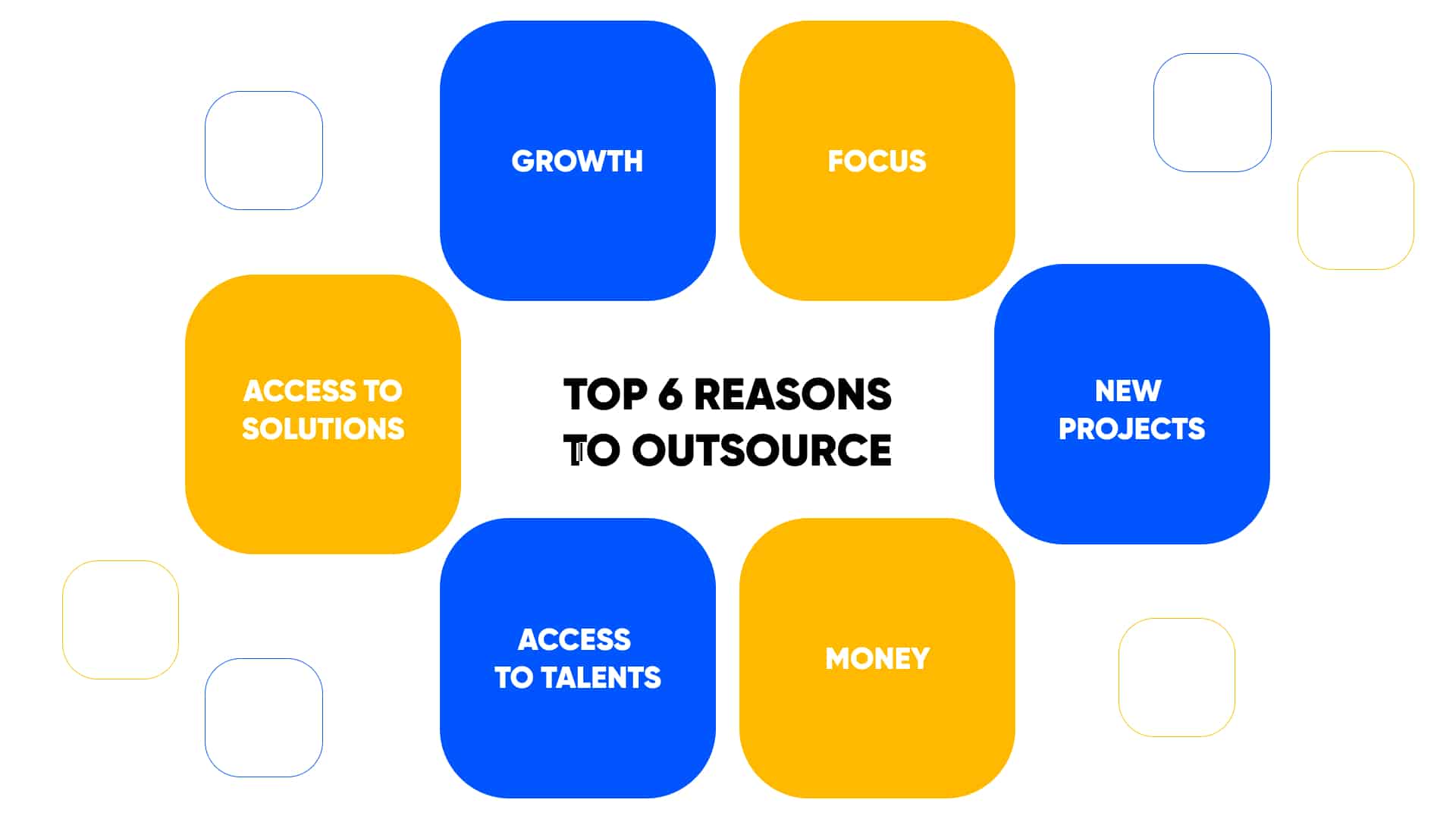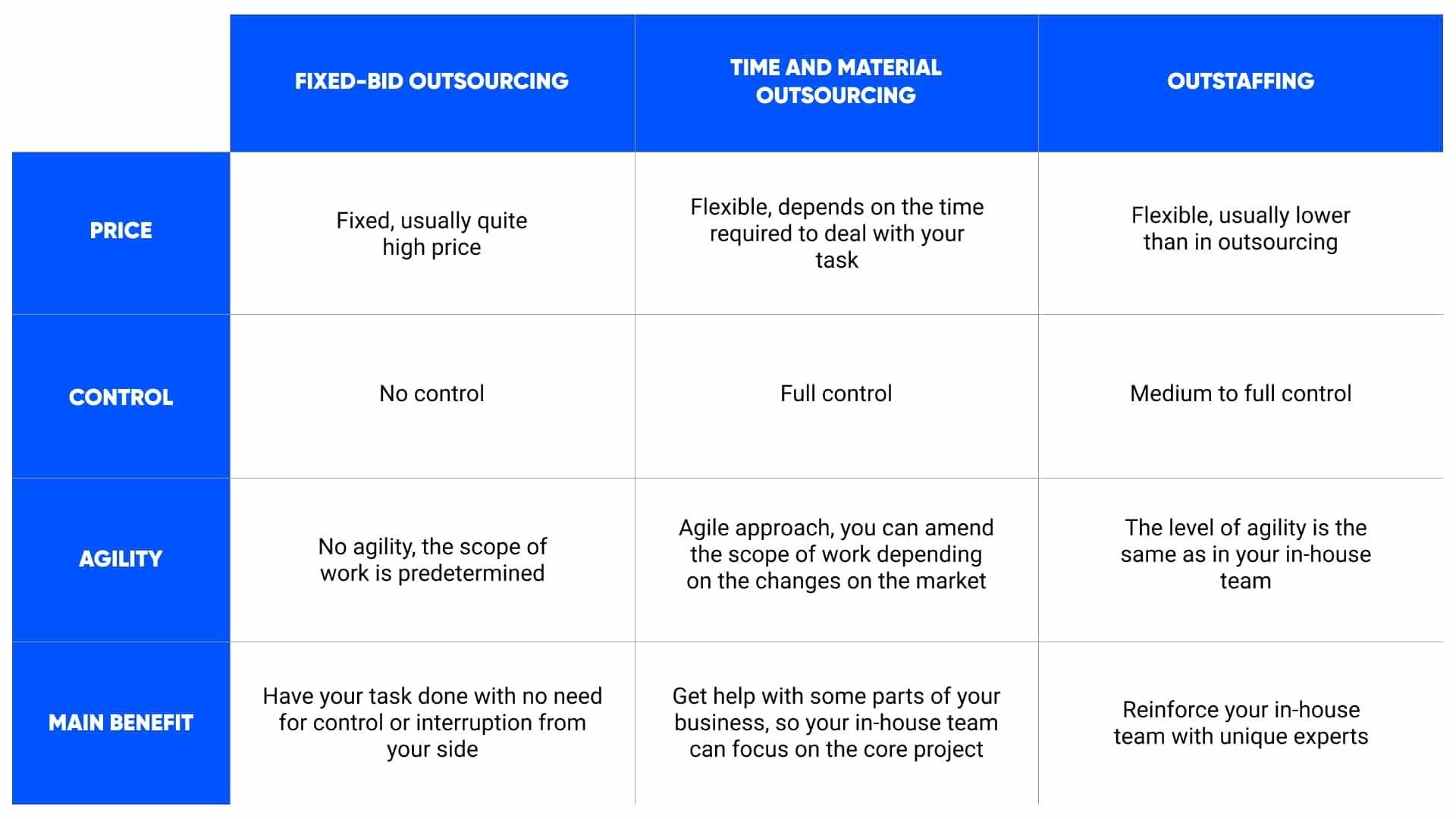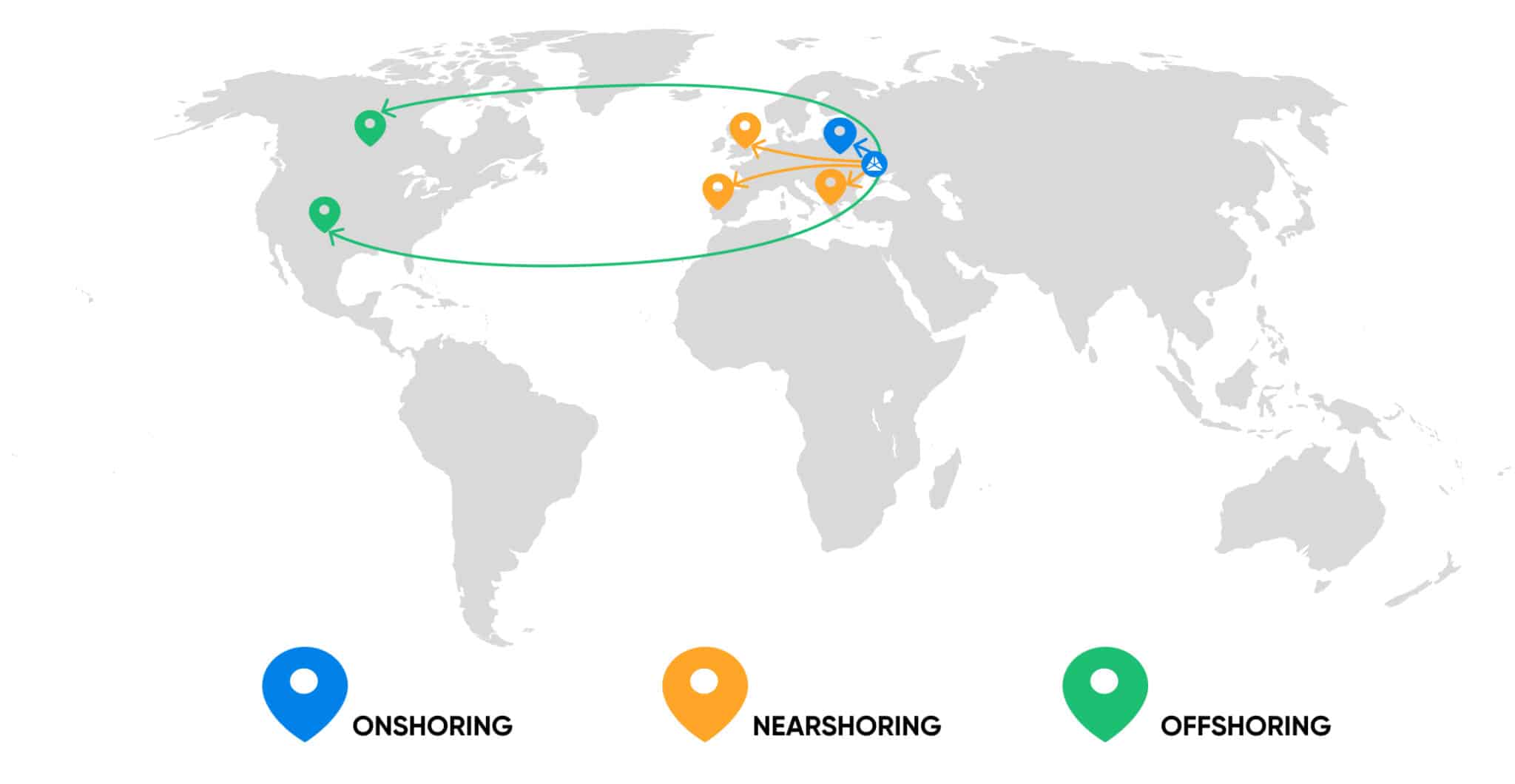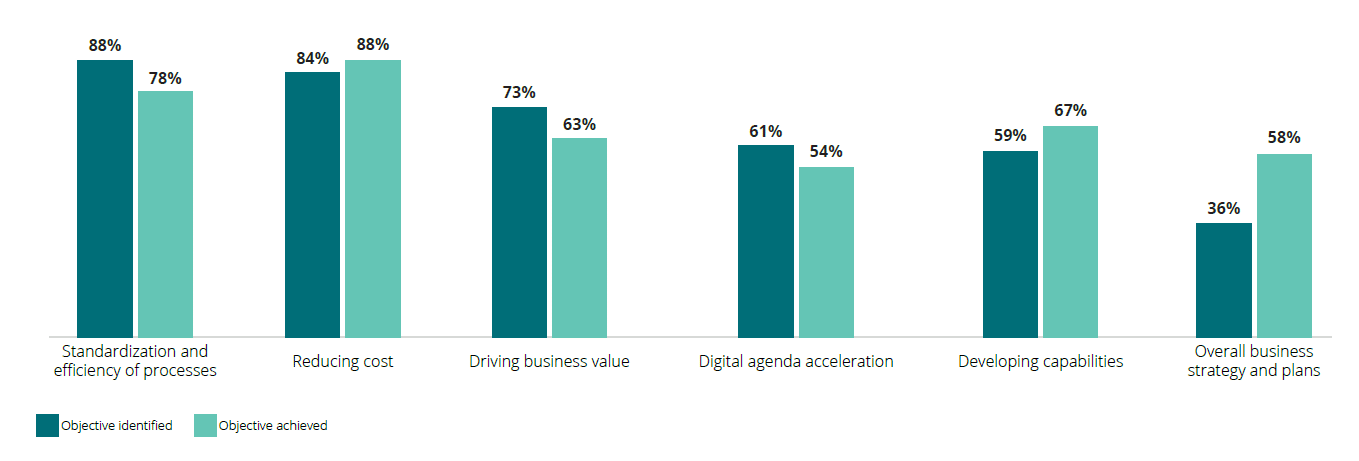According to top managers of IT giants like Twitter, Meta, and Amazon, one of the reasons for massive layoffs in November’22 and January’23 was extremely optimistic overhiring during the Covid-19 pandemic. If tech companies opted for outsourcing or outstaffing back in 2020-2021, there might be no current crisis in the IT sphere, with thousands of tech talents finding themselves overboard.
Content:
- The difference between outsourcing and insourcing
- Types of delegating business and operational tasks to third parties
- Classification of outsourcing by the geographical proximity of the third party
- What are the peculiarities of outsourcing in 2023?
- Examples of things that could go wrong when outsourcing is not approached strategically
- What are some examples of outsourcing?
- Examples of how outsourcing benefits influence employees
- Summing up: What should we expect from outsourcing in 2023?
In this article, MWDN discusses software development and digital services outsourcing, gathers some primary classifications of outsourcing, and sees what benefits and downsides this business approach has. Part of this blog post will be dedicated to successful and failed examples of outsourcing and predictions for the year to come.
The difference between outsourcing and insourcing – when each of them should be used
By opting for outsourcing, you choose to delegate some of the business or operational tasks of your company to third parties which are outside your organization. Insourcing is the opposite approach to taking care of business tasks, and it provides that you find, hire, train, and manage new personnel for your new or current tasks.
Here’s a brief list of situations when companies can consider hiring a third party:

- Growth. The business is growing, and new employees are needed to cover all working tasks.
- Focus. The company wants its in-house employees to focus on the main project, so it needs someone to take care of the rest.
- New projects. If a company has in mind an idea for a new project, it might look for a devoted remote team of experts who would take it upon themselves.
- Money. It’s the case when the cost of living in the country where the company is from is quite high, as well as the salaries of tech talents. If the company is tight with its budget, it might consider outsourcing some of its tasks to cut labor costs.
- Access to talents. The particular business tasks cannot be solved by experts present in the local labor market of the city or country.
- Access to existing solutions. There are existing solutions for particular technical tasks on the market, and the customer wants to use them without the need to “reinvent the bicycle” on their own.
Even though these are often the reasons why companies choose to outsource, some business entities might decide that it’s better to hire a fully-fledged in-house team of technical or other specialists.
Suppose you’re scaling your business and increasing the personnel by 30%. In that case, you have two options: employ additional accountants for your in-house accounting department to manage all the payrolls or delegate the payroll function to the third-party company specializing in employee accounting operations.
Let’s compare the pros and cons of these two approaches:
| Outsourcing pros: 1. You can save money on direct labor costs. 2. You can get access to the best business practices and the most skilled experts. 3. Outsourcing is an easy and fast way to scale your business. 4. It is considered a flexible and agile approach. 5. You can increase speed to the market. 6. Better competitive advantage due to the higher efficiency of the processes. | Insourcing pros: 1. You can share corporate values and principles with in-house employees. 2. Your in-house employees are fully engaged and involved in your project. 3. You can nurture new managers and team leads from people working in your company in-house. 4. You manage your in-house team and promptly make amendments to their work when necessary. 5. Faster and better communication. 6. Better quality control. |
| Outsourcing cons: 1. You don’t have control over the working processes and can’t implant your business values over the third party. 2. Even when your vendor company has signed an NDA contract, security and confidentiality risks remain. 3. Lack of quality is possible. | Insourcing cons: 1. Maintaining an in-house team, as a rule, leads to higher labor expenses. 2. Whenever you are forced to cut your personnel, you will face severance pay. 3. As a rule, you’re limited to the labor market of your city or country. |
Wouldn’t it be great to have a mixed model of the best from outsourcing and insourcing but with no side effects? Actually, there is a business model that combines the two – outstaffing. Find out more about it in the next section.
Types of delegating business and operational tasks to third parties
For years, there have been three main approaches to delegating software development and other IT services: fixed-bid (or fixed-price) outsourcing, time and material outsourcing, and outstaffing (also known as staff augmentation or dedicated teams).
All three of them are pretty popular as they answer the different needs of their customers. Fixed-bid outsourcing is a perfect choice for a company that:
- has a large budget (prices of fixed-bid outsourcing services are quite high),
- knows exactly what it wants (with fixed-bid outsourcing, you provide all the technical demands and describe the scope of work before you sign a contract),
- doesn’t need the full involvement of an IT vendor in the peculiarities of the customer’s business,
- doesn’t have an in-house IT department.
With fixed-bid outsourcing, you pay for the whole project beforehand and wait until the due date when the whole project will be released.
Time and material outsourcing will suit another kind of customer. They:
- are not yet sure about the scope of work they need to be performed,
- want to get tasks performed in iterations and pay only for things that have already been implemented,
- want to maintain control over their expenses and the time of their remote employees,
Outstaffing is a cooperation model that will suit only those companies which:
- already have an in-house IT department which, however, needs to be reinforced with external experts,
- need to make amendments to the scope of work depending on the changes in the market or new analysis data,
- want its new remote employees to be fully involved in the project and stay a part of their team for a prolonged time,
- prefer strategic cooperation to one-time vendor/customer relations.

In practice, it looks like that:
A non-tech company that has only a helpdesk department and no developers or web designers (like a perfumery distributor, fashion buyer, or ceramic producer) would use a fixed-price outsourcing company for the development of its app or e-commerce website.
Both non-tech and IT companies can opt for time and material outsourcing. They would choose this approach for business cooperation when they need temporary assistance with some tasks or projects.
Outstaffing is mainly for tech companies, which have their own software projects but suffer from a knowledge gap in their in-house team of developers.
Classification of outsourcing by the geographical proximity of the third party
The geographical position of the third party is yet another way to classify outsourcing. According to this typology, there are offshoring, onshoring, and nearshoring.

Offshoring is when you hire an IT vendor that is situated on another continent. For example, you’re a Canada-based company that gets help with software development from the Philippines.
The main benefit of offshoring is that, as a rule, in this case, customers from countries with a high cost of living hire outsourcing companies from countries with a low cost of living. By doing so, they win on the geographical discrepancies in salaries and cut their direct labor costs.
Nearshoring is when you go to the neighboring countries to find an outsourcing company for your needs. For example, you’re from Germany, and you opt for a Polish IT vendor, or you’re a US-based company that chooses a Mexican counterpart.
With nearshoring, you will still be able to cut labor expenses a bit (though it’s not always the case), but what’s more important is that the company you will work with will most likely consist of people who speak your language, share your business and cultural values, and live at the same time zone as you do.
Onshoring is probably the most common type of business cooperation. In this case, you hire an outsourcing company from your country, your region, or even your city.
There might be no major labor expenses cut in this case. However, you still get all other benefits of outsourcing, particularly – delegating some of your business or operation processes to a third party so you can decrease the workload of your in-house team and focus on your core project.
What are some examples of outsourcing?
Outsourcing has changed in recent years. Just a decade ago, companies preferred outsourcing functions that didn’t require a vast skill set from employees, like assembly line manufacturing.
In 2021 (the year when the following data was gathered), however, IT, finance, and payroll were among the top-3 business functions most often delegated to third parties.

Here are some other functions that might be outsourced in various industries.
IT functions that can be delegated to third parties
- Website development
- Application development
- IT security and cybersecurity
- Project management and delivery management
- Business analysis
- Artificial intelligence and machine learning
- Blockchain technologies
- Natural language processing
- AR and VR technologies
- Quality assurance
- Content marketing and SEO
- Web design
This list is not explicit. If you have some IT project in mind and are looking for professional assistance with it, don’t hesitate to contact MWDN.
What are examples of HR outsourcing?
- Payroll and employee taxes
- Monthly support of employees
- Training and professional development
- Onboarding
- Compensation strategy
- Troubleshooting
- Psychological assistance
- Team building and other corporate activities
- Corporate culture and values development
- Employee engagement
What are examples of business outsourcing?
Just several years ago, CEOs and COOs thought that vital business functions, like strategic management, should, in any case, be outsourced. Today, however, there are fewer such superstitions, and you can delegate any function, from top management to premises caretaking. Here are just some examples of business processes you can outsource:
- Management
- Marketing
- Sales
- Logistics
- Manufacturing
- Administration
- Customer support
- Advertising
- Digital transformation
- Content creation
- Research and development
- Recruitment
- Finance
- Law support
What are some examples of government contracting and outsourcing?
In most cases, the private sector is driven by competition and is better developed and innovative than governmental agencies. In the US, all departments, be it the Army, NASA, or Nuclear Regulatory Commission, delegate some of their functions to third parties from the private sector. These are the same functions that are outsourced by businesses:
- payroll,
- human resources,
- acquisition services,
- real estate and logistics,
- financial management, and
- data center hosting.
According to the Government Business Council, nearly all federal managers (92%) say that their agency currently outsources services.
Who has used call center outsourcing? Examples.
It is easier to list the industries that outsource their call centers than all the companies that do so. These are just some of them:
- Telecommunication companies
- Technology companies
- Banking and financial institutions
- Utility sector
- Booking platforms
- Logistics companies
- Large e-commerce
They have two principal reasons for outsourcing their call centers:
- To access the best business practices, tools, and talents on the market (AI customer support bots, multichannel call centers that collect calls and messages from all channels in one tab, multilingual 24/7 call centers, etc.) and
- To cut costs.
The latter is the reason why call centers are usually outsourced to countries with relatively lower costs of living, like India, Vietnam, the Philippines, Ukraine, or Poland.
Examples of things that could go wrong when outsourcing is not approached strategically
Consider your IT vendor as a strategic partner, which affects your goodwill, development, and future. Only in this case will you be able to choose a trustworthy contractor that won’t disappoint you. Here are some of the ways in which an unsuitable outsourcing company can cause more trouble than good.
Lack of communication

A classic example of miscommunication happened in 2004 between the US Navy and EDS (Electronic Data System) outsourcing company. Due to the excessively bureaucratic language of government agreements, the IT vendor didn’t get their contract with the Marines quite well. Namely, that it was not merely a training personnel contract but also the obligation that the EDS abided by signing a contract to integrate or change thousands of legacy apps. As a result, the Electronic Data System paid half a billion dollars to the US Navy and by 2004 reported a loss of more than $150,000.
Lack of expertise

Lack of proficiency, skills, and expertise in IT vendors is something most customers are afraid of. One of the reasons is that it is so hard to prove to the court that your counterpart was not good enough. The case of Hertz vs Accenture demonstrates that achieving justice is still possible.
In 2016, the car rental giant Hertz hired software development company Accenture to transform their app and website into something more modern. The customer had all its plans for the future written down in the technical demands for the project. Accenture, on their behalf, either didn’t read the documentation or simply chose to do a flip-flop job – in the end, the customer found itself with a product that suited only North America and was not appropriate for scaling their business.
The court’s decision came up only in 2019 and obliged Accenture to pay Hertz almost 32 million US dollars.
Error response

Making mistakes is not a sin, even for a reliable and trustworthy IT vendor. What matters instead is how you react to your mistake. The too-slow, insufficient, and irresponsible reaction was the case of Navitaire in 2010.
Back then, the outsourcing company that created an e-commerce platform for Virgin Australia responded to the broken disk drive in the wrong way. Instead of going to the backup drive, Navitaire tried to fix the broken one but didn’t manage to do it promptly, causing millions of dollars of losses for Virgin Australia and 24 hours of delays for thousands of clients.
Destroyed brand image
In the modern world of absolute transparency, it is hard to conceal your partners, their flaws, or the immoral aspects of your cooperation. One of the most notorious examples where outsourcing has been a failure is the 2013 case of Zara and H&M outsourcing to Bangladesh, which has drastically affected the image (and sales) of these mass-market fashion brands. Quick reminder: back in 2013, more than eleven hundred employees of a garment factory in Bangladesh died in a fire caused by poor working conditions. This tragedy caused massive accusations of the fashion brands for lack of business ethics and immoral competition.
Going back to 2023, we can think of multiple cases where international IT companies were forced to switch from one counterpart to another because their previous IT vendor was from Russia, now banned by most of the world.
It’s not only their fault!

In 2012, the Royal Bank of Scotland hired the unnamed, presumably Indian IT vendor to update their software. However, due to an internal mistake of the in-house technical department of the bank, the update failed, which caused millions of the bank clients to be incapable of accessing their accounts and made the financial institution pay more than 40 million pounds fine to the Financial Conduct Authority.
What should we expect from outsourcing in 2023?
We predict the development and growth of outsourcing this year. One of the reasons is that this cooperation business model has repeatedly proven its efficiency.
Objectives of outsourcing and their achievement

Another reason for the estimated growth, particularly in the IT sector, is that today we can see how dangerous overhiring might be. After massive layoffs in technology giants, companies will think twice before enlarging their staff with in-house employees and will more likely opt for IT vendors instead.
Third, outsourcing remains one of the significant sources of income for many developing countries, so the rest of the world can “kill two birds with one stone” and simultaneously drive their business value and help other countries build their economy.
We also can predict that with the growing competition among outsourcing and outstaffing companies, the quality of their services will only rise, providing even more customer benefits.
Summing up, we can state that we are at the peak of outsourcing popularity, with 2023 being the best year to start outsourcing IT services and other business processes.
Content
- 1 The difference between outsourcing and insourcing – when each of them should be used
- 2 Types of delegating business and operational tasks to third parties
- 3 Classification of outsourcing by the geographical proximity of the third party
- 4 What are some examples of outsourcing?
- 5 Examples of things that could go wrong when outsourcing is not approached strategically
- 6 What should we expect from outsourcing in 2023?
